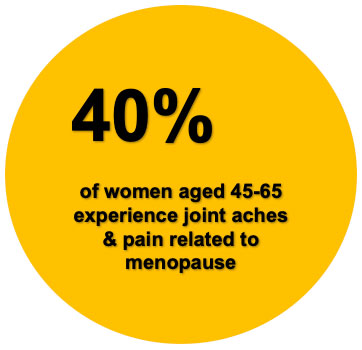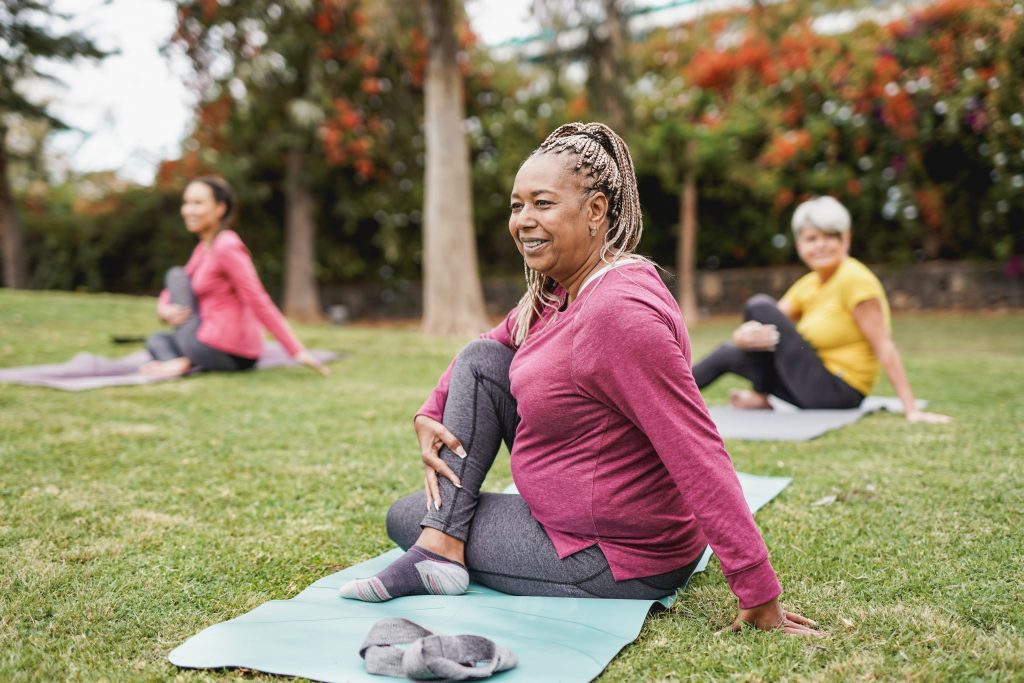
Have you ever noticed how your joints have suddenly started to ache for no apparent reason?
Have you found it’s harder to exercise because your muscles and joints seem to run out of steam a lot quicker than they used to, or it takes you longer to recover when you do exercise?
These are very common feelings as we transition through menopause. I know I started to find it harder to recover after I’d done a long run or had pushed myself in the gym. The DOMS Delayed Onset Muscle Soreness) seemed to come on quicker and last for longer than before! There are some scientific reasons behind this that isn’t just about the normal ageing process. As we transition through perimenopause, menopause and into post-menopause, the changes in our hormone levels can have impacts on how our bodies function.
What is menopause-related joint pain?

Many women say they experience joint aches and pains as they transition through menopause, so you aren’t alone. However, before you blame everything onto menopause and hormonal imbalances you will need to make sure that you don’t have an underlying condition that might be causing you to feel these aches and pains.
During menopause, we are at a greater risk of developing osteoarthritis especially in our hands. As a keen knitter I know I’ve noticed more aches and pains in my hands – I can’t hold the wool as well as I used to and sometimes need to modify my knitting technique to make sure my finger joints don’t start to hurt! Osteoarthritis is caused quite simply by wear and tear on our joints, something that happens naturally as we age.
What causes our joints to ache more as we transition through menopause?
The easy answer here is hormone imbalances and in particular fluctuations in our oestrogen levels. Oestrogen affects our cartilage, that’s the tissue in our joints, as well as bone turnover (the natural replacement of bone in our bodies). As oestrogen plays such an important role in keeping our joints and bones in good working order so it follows that as oestrogen levels decrease, we can be more prone to inflammation or pain. It also follows that joint pain can be experienced through all stages of the menopause:
- Perimenopause – this is when progesterone reduces, leaving higher levels of oestrogen in our systems. As oestrogen becomes more dominant in the early stages of menopause, we may not notice joint pain right away, but as those levels start to fluctuate that will change. For many women, aching joints can be the first signs of perimenopause.
- Menopause – this is when we’ve been period-free for 12 months or more and when oestrogen starts to even out at a much lower level. If you’ve not experienced joint pain before, then you may start noticing this now.
- Post-menopause – this is the stage when our hormonal imbalances start to level off, but we can become more prone to osteoarthritis and osteoporosis due to the lack of oestrogen. Again, this will coincide with our natural ageing and so we may well notice more joint aches and pains as a result.
What can we do to overcome joint pain?

Firstly, it’s always good to seek professional medical advice especially if you are noticing heat or swelling in your joints. Once you’ve ruled out any underlying health conditions the are some simple things, we can do to help our body to better manage the hormonal impacts on our joints as we transition through menopause.
- Weight control – no silver bullets here I’m afraid! We all know we can be prone to weight gain as we transition through menopause as our bodies become less effective at burning calories. Because of our aches and pains and the lack of testosterone that gives us the motivation and energy to exercise, we may find we aren’t moving as much too. The more weight we are carrying then the greater the stress we are placing on our muscles, joints, and bones. Extra pounds can lead to many problems including arthritis, tendonitis, and bursitis. Weight can cause the cartilage on the end of our bones to become damaged or worn and this can lead to pain, stiffness and sometimes swelling in our joints.
- Stress reduction – stress can be a real problem for our minds and our bodies. When we feel stressed, our bodies go into “fight or flight mode” and start to flood our systems with adrenaline and cortisol. As we transition through menopause it’s our adrenal glands that take over producing oestrogen but at much lower levels than our ovaries. When our brain perceives danger, our adrenal glands will prioritise survival over fertility and stop producing oestrogen altogether. We know that becomes an issue for our muscles, joints, and bones. Adrenaline will cause our breathing to quicken, our heart rate to increase, and our muscles to tense in preparation to move. This reaction is fine in the short term, but when it fires repeatedly, the increased tension in our muscles can amplify our arthritis-like pain and set off our immune system’s inflammatory response.
- Quality sleep – lack of quality sleep is one of the most important aspects of our health. It’s not uncommon for people who sleep poorly to have joint pain. According to a 2012 research project, sleep deprivation can cause achy; painful joints which in turn may increase sleep deprivation. People suffering with osteoarthritis often struggle to fall asleep, have difficulties sleeping throughout the night and problems waking up too early. Menopause can also cause our sleep to become disrupted, thus adding to our experience of sleep deprivation. There may also be a link between joint lubrication and poor sleep. During the day, our joints move and flex regularly which stimulates the release of lubricants keeping our joints pliable. When we sleep, our joints stop moving and begin to stiffen which may contribute to increased pain during the night leading to poor sleep.
- Cognitive Behavioural Therapy (CBT) & Mindfulness – both techniques challenge your thinking and mindset and can be very helpful in managing pain. Mindfulness encourages us to focus on our breathing which has been shown to help alleviate stress as well as helping us to manage pain. Remember how you were encouraged to breath during childbirth?
- Yoga and Pilates – both disciplines are excellent for increasing our flexibility, suppleness, posture, and strength. Both rely on controlled breathing throughout and so can help to reduce stress and encourage greater relaxation.
- Over-the-counter remedies – these include painkillers which can help to remove pain, or gels that can be applied direct to the skin in the affected areas. You can also try supplements or vitamins such as turmeric, glucosamine or omega 3 or 6 which can all benefit the way in which our bodies replenish connective tissue.
- Remain hydrated – of course making sure we drink enough water daily will help to keep our minds and bodies hydrated and lubricated. The loss of oestrogen at menopause causes our cells, both externally and internally, to lose hydration and plumpness. Drinking enough water will help to slow this process.
- HRT – this is a given as it replaces the hormones we lose as we transition through menopause.
More help with menopause joint pain
As you can see with everything relating to menopause, there are no quick fixes and so much relies on our noticing the changes in our bodies and making simple lifestyle changes that will support our bodies through this transition. Remember whilst you may want to stop your joints aching in the short-term, making changes now to the way you live your life will mean you can benefit from a healthier body way into post-menopause and beyond.
If you’d like to learn more about How to Beat Aching Joints through Menopause, then email me now as I have a FREE event happening soon in my Facebook group as well as the start of my 12-week Phoenix Rising Mastermind programme on the 7th June which will look at all aspects of thriving through menopause.

